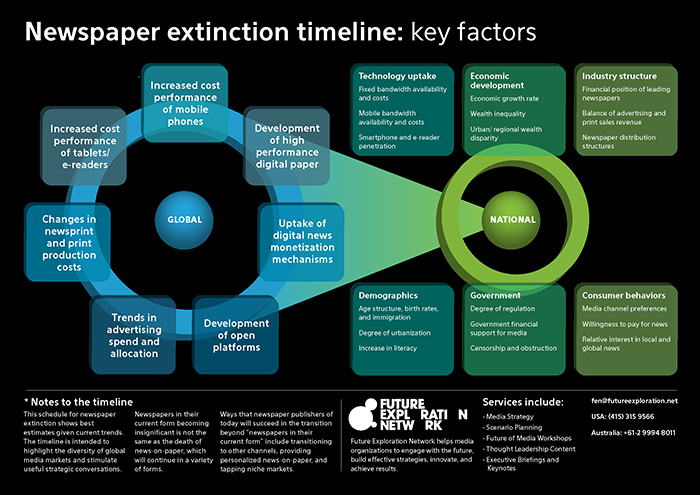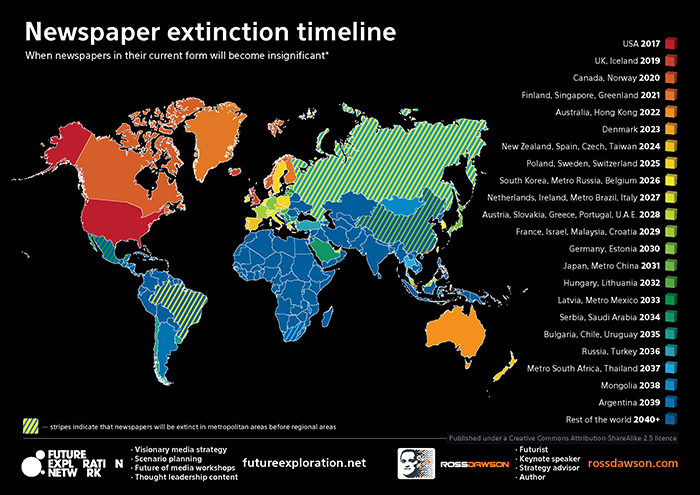Keynote Speaker
Keynote Speaker
Books
In the media
Business Model
Selection of Ross Dawson Frameworks
Newspaper Extinction Timeline

Click on the image to see full-size pdf
This framework has been seen well over 1 million times through its publication in newspapers (!) and other media outlets in over 30 countries. It is designed to be provocative, and has certainly generated significant controversy. In general I do not believe in making specific forecasts, as the future is unpredictable. However it can be useful to be very specific, as it can sometimes generate more pointed thinking than generalities. Certainly the news-on-paper industry needs some very focused thinking today.
When newspapers in their current form will become insignificant*
USA: 2017
UK, Iceland: 2019
Canada, Norway: 2020
Finland, Singapore, Greenland: 2021
Australia, Hong Kong: 2022
Denmark: 2023
New Zealand, Spain, Czech, Taiwan: 2024
Poland, Sweden, Switzerland: 2025
South Korea, Metro Russia, Belgium: 2026
Netherlands, Ireland, Metro Brazil, Italy: 2027
Austria, Slovakia, Greece, Portugal, U.A.E.: 2028
France, Israel, Malaysia, Croatia: 2029
Germany, Estonia: 2030
Japan, Metro China: 2031
Hungary, Lithuania: 2032
Latvia, Metro Mexico: 2033
Serbia, Saudi Arabia: 2034
Bulgaria, Chile, Uruguay: 2035
Russia, Turkey: 2036
Metro South Africa, Thailand: 2037
Mongolia: 2038
Argentina: 2039
Rest of the world: 2040+
FACTORS DRIVING THE PACE OF NEWSPAPER EXTINCTION
GLOBAL
Increased cost performance of mobile phones
Increased cost performance of tablets/ e-readers
Development of high performance digital paper
Changes in newsprint and print production costs
Uptake of digital news monetization mechanisms
Trends in advertising spend and allocation
Development of open platforms
NATIONAL
Technology uptake
Fixed bandwidth availability and costs
Mobile bandwidth availability and costs
Smartphone and e-reader penetration
Economic development
Economic growth rate
Wealth inequality
Urban/ regional wealth disparity
Industry structure
Financial position of leading newspapers
Balance of advertising and print sales revenue
Newspaper distribution structures
Demographics
Age structure, birth rates, and immigration
Degree of urbanization
Increase in literacy
Government
Degree of regulation
Government financial support for media
Censorship and obstruction
Consumer behaviors
Media channel preferences
Willingness to pay for news
Relative interest in local and global news
* Notes to the timeline
This schedule for newspaper extinction shows best estimates given current trends. The timeline is intended to highlight the diversity of global media markets and stimulate useful strategic conversations. Newspapers in their current form becoming insignificant is not the same as the death of news-on-paper, which will continue in a variety of forms. Ways that newspaper publishers of today will succeed in the transition beyond “newspapers in their current form” include transitioning to other channels, providing personalized news-on-paper, and tapping niche markets.





































